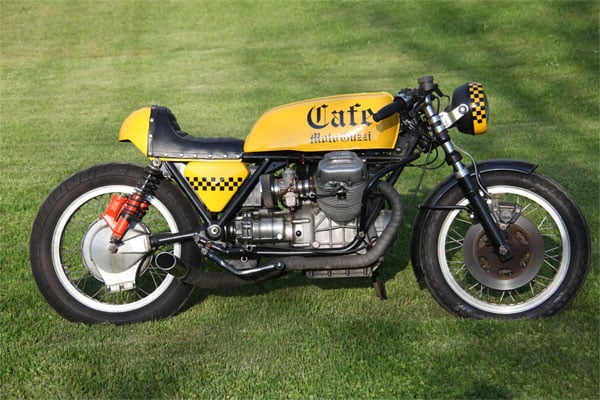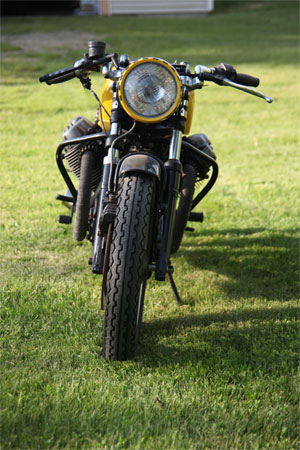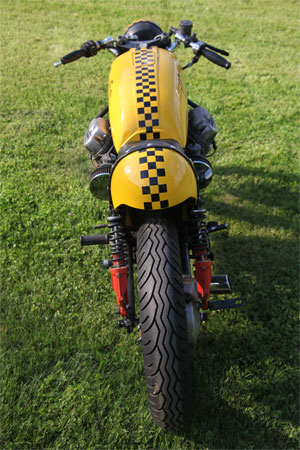
small image library medium image library large image library
|
| 23 images of this bike are available by clicking: small image library medium image library large image library |
And now we present a 1975 Moto Guzzi cafe racer designed and built by the legendary Steve Bolvari.
This spectacular cafe racer started life as a Moto Guzzi 850T, before it was hand built by Bolvari. A "cafe racer" is a motorcycle genre that had its start in London with the famous Ace Cafe "rockers" (the original name for bikers in the UK) of the early 1960s. It is very unusual to find early 1970s Moto Guzzis converted into a cafe racer.
The Moto Guzzi 850T has an 844 ccm V2 four-stroke engine. In unmodified form it made 55 HP at 6100 RPM. It has a 5 speed gearbox and shaft-drive. It originally weighed 562 lbs wet, yet could reach 112mph. Naturally, this cafe racer is much lighter and has had some performance modifications made that are befitting of the genre.
The Ace Cafe became the place to meet, have a meal or cup of tea, arrange runs (often to other cafes or the coast) or simply to work on your bike. People came to listen to the juke-box, many subsequently starting bands or clubs. Some of whom gained considerable reputation and success. From this powerful fusion of motorcycles and Rock ´n´ Roll came the legends of street-racing - "drop the coin into the slot of the juke-box" - and race to a given point and back before the song finished. The Ace Cafe, with its combination of motorbikes, speed and Rock ´n´ Roll was the launch pad for many famous racers and the birthplace for many bands.
 It was also the birthplace for the "cafe racer". In the 1960s, in order to reach the 100mph (or ton-up), one had to reduce the weight of the bike. Most everything unnecessary was removed.
It was also the birthplace for the "cafe racer". In the 1960s, in order to reach the 100mph (or ton-up), one had to reduce the weight of the bike. Most everything unnecessary was removed.
From Wiki: A classic example of this was to race from the Ace Cafe on The North Circular road in NW London to the Hanger Lane junction as it then was - it is now the more famous Hanger Lane Gyratory System - and back again. The aim was to get back to the Ace Cafe before the record you'd put onto the jukebox had finished. Given that some of the Eddie Cochran tunes that were in vogue at this time were less than two minutes long, the racers would have had to traverse the three miles round trip at extremely high speed.
The cafe racer is a motorcycle that has been modified for speed and good handling rather than comfort. Cafe racers' bodywork and control layout typically mimicked the style of contemporary Grand Prix roadracers, featuring an elongated fuel tank and small, rearward mounted, humped seat. A signature trait were low, narrow handlebars that allowed the rider to "tuck in" to lessen wind resistance and offered better control when in that posture. These are referred to as either "clip-ons" (two-piece bars that bolt directly to each fork tube) or "clubmans" (one piece bars that attach to the stock mounting location but drop down and forward). The ergonomics resulting from low bars and the rearward seat often required "rearsets," or rear-set footrests and foot controls, again typical of racing motorcycles of the era. Distinctive half or full race-style fairings were sometimes mounted to the forks or frame. The bikes had a raw, utilitarian and stripped-down appearance while the engines were tuned for maximum speed. These motorcycles were lean, light and handled road surfaces well. The most defining machine of its heyday was the homemade Norton Featherbed framed and Triumph Bonneville engined machine called "The Triton". It used the most common and fastest racing engine combined with the best handling frame of its day, the Featherbed frame by Norton Motorcycles. Those with less money could opt for a "Tribsa" - the Triumph engine in a BSA frame.



This cafe racer was built by Steve Bolvari of MOTO CUSTOMZ INC. Steve has built a number of show winning bikes. Perhaps, the most notorious is the Moto Guzzi chopper that took People's Choice award two years in a row at the 2005 and 2006 IMOC Rally.
This bike was modified from a 1975 850T Moto Guzzi. Lots of custom made parts were installed. Straight intake manifolds matched to intake transfer with 38mm Mikuni carburetors. It has an increased diameter two into one exhaust that is characteristically wrapped with heat wrap, and is as far as I can tell, un-muffled. The frame has had some modifications with the front dropped 1 1/4 inches. A pair of 13 1/2" Marzocchi air shocks have been installed. Wide clip on handlebars are used but retain the older controls for the authentic old school look. The paint is very fresh and includes the original Bolvari "Cafe" logo and his signatury checkered-flag motif. A custom seat has been built.

 This bike was purchased in CT from an enthusiast who purchased it from another enthusiast in Mass. It currently has a Mass title. You will notice that the speedometer and tachometer have been removed from the controls area to simplify the presentation. Because there is no longer a speedometer on this bike, it is impossible to know the mileage. Likewise, there is an absence of turn signals as well as a brake light. There is a mounting plate for a license plate located on the left rear shock at its bottom mount bolt. Although many New England states allow for the absence of these controls due to the age of the bike, you will need to check your own State laws or consider adding details such as a brake light if you do not feel safe signaling with your hands. A true "Rocker" would not want the bike dragged into a contemporary context with notification signals.
This bike was purchased in CT from an enthusiast who purchased it from another enthusiast in Mass. It currently has a Mass title. You will notice that the speedometer and tachometer have been removed from the controls area to simplify the presentation. Because there is no longer a speedometer on this bike, it is impossible to know the mileage. Likewise, there is an absence of turn signals as well as a brake light. There is a mounting plate for a license plate located on the left rear shock at its bottom mount bolt. Although many New England states allow for the absence of these controls due to the age of the bike, you will need to check your own State laws or consider adding details such as a brake light if you do not feel safe signaling with your hands. A true "Rocker" would not want the bike dragged into a contemporary context with notification signals.
The motor runs strong and would be considered a "torque monster". The original 850T could make over 110mph. This bike weighs considerably less and has performance modifications. My own experience riding this bike is that it is incredibly thrilling. It is not just the absence of a fairing, but also the seating position that makes the ride more similar to riding in a WW1 vintage aircraft than a late 70's touring bike (for which it was originally intended). The carburetors' air cleaners rest against the knees and when the throttle is opened make nearly as much intake noise as the unmuffled exhaust. The gears shift smoothly and the bike will run hard and fast or cruise easy and mild. The amount of vibration expected from a huge V-Twin is tempered by the shaft drive.
 There is no longer a key start on this bike because the controls area has been modified for minamilism. There is a big toggle switch in its place and a push button starter that is located just at the edge of the bottom of the seat. After choking the two carbs, pushing the button fires the huge V-Twin to power. Although unmuffled, I do not believe that this bike will exceed maximum levels for noise. There may be a baffle installed further into the pipe than is obvious. But between exposed carburetors and the two into one exhaust, this bike makes an audible statement that should endear itself quickly to Harley Davidson riders who enjoy a bit of bang with their bike.
There is no longer a key start on this bike because the controls area has been modified for minamilism. There is a big toggle switch in its place and a push button starter that is located just at the edge of the bottom of the seat. After choking the two carbs, pushing the button fires the huge V-Twin to power. Although unmuffled, I do not believe that this bike will exceed maximum levels for noise. There may be a baffle installed further into the pipe than is obvious. But between exposed carburetors and the two into one exhaust, this bike makes an audible statement that should endear itself quickly to Harley Davidson riders who enjoy a bit of bang with their bike.
This is obviously the ultimate poser's bike - which was what Rockers was all about...being seen, being loud, and being very, very fast with a bit of devil may care attitude.
Location: Vermont
Priced at US$3,800.
Shipment must be arranged and paid for by Buyer. Seller is willing to assist in arrangements. Contact the owner by email by clicking here.
23 images of this bike are available by clicking:
small image library medium image library large image library
Additional bikes of interest for sale by Owner are 1999 Ducati M900 custom cafe, 1999 immaculate HRC RS250R, 1999 original Aprilia RS250 Challenge Cup in mint condition. Bikes already sold by Owner are Bimota V-Due 500.